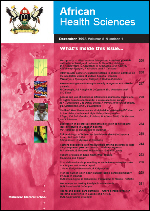
|
African Health Sciences
Makerere University Medical School
ISSN: 1680-6905
EISSN: 1680-6905
Vol. 15, No. 2, 2015, pp. 546-551
|
 Bioline Code: hs15075
Bioline Code: hs15075
Full paper language: English
Document type: Research Article
Document available free of charge
|
|
|
African Health Sciences, Vol. 15, No. 2, 2015, pp. 546-551
| en |
Determinants of fertility in Ethiopia
Ayele, Dawit Getnet
Abstract
Background: The most important elements to determine the rate of population growth is fertility. Fertility is the main
element to affect the welfare of mother. The survival of a child can be affected by high fertility and shorter birth intervals.
Methods: For this study, the linear mixed model was used to determine factors affecting fertility status of women in Ethiopia.
The 2011 Ethiopian demographic and health survey data was used for this study.
Results: From the result, materials used for roof, wall and floor were found to have a significant relation to fertility level of
women in the last five years. Moreover, family size and births in the last five years were found to have a significant relationship.
Conclusion: Significant variation in fertility level was observed among rural and urban residents of Ethiopia. To reduce
the gap of fertility between rural and urban population, it is important to modernize different factors. These factors could
be access to education, media, and providing employment opportunities in the modern economic sector. Besides this, it is important to develop and maintain the access of family planning services.
Keywords
EDHS; fertility; LMM; VC
|
| |
© Copyright 2015 - African Health Sciences
|
|
